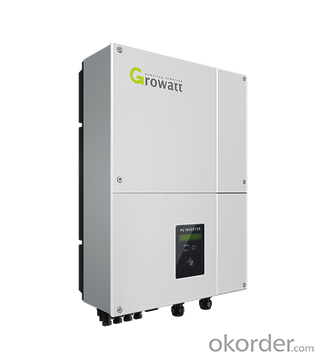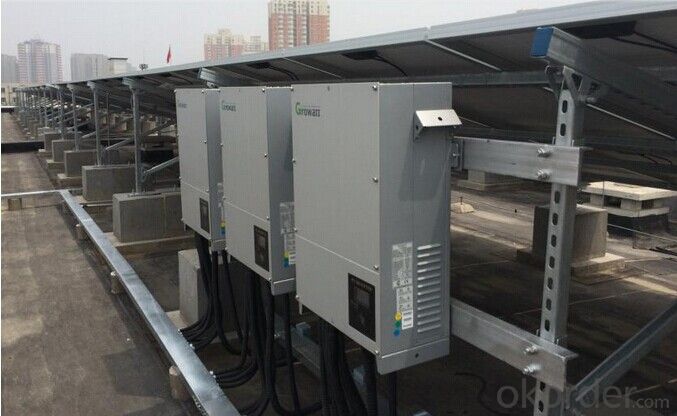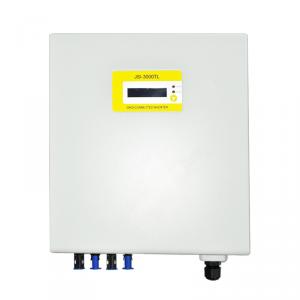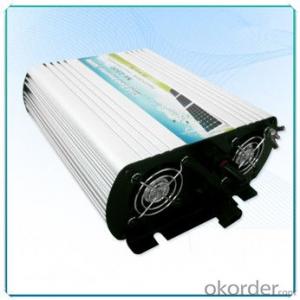Solar Inverter 3600W-5000W Grid Tied Solar Inverter
- Loading Port:
- Shekou
- Payment Terms:
- TT or LC
- Min Order Qty:
- 10 pc
- Supply Capability:
- 10000 pc/month
OKorder Service Pledge
OKorder Financial Service
You Might Also Like
Solar inverter 3600W-5000W Grid Tied inverter
Maximum efficiency of 97.9% and wide input voltage range
Internal DC switch
Transformerless GT topology
Compact design
Multi MPP controller
MTL-String
Bluetooth/ RF technology/ Zigbee/ Wi-Fi
Sound control
Easy installation
String Inverter
Maximum efficiency of 97.9% and wide input voltage range and dual MPPT design enable flexible installation
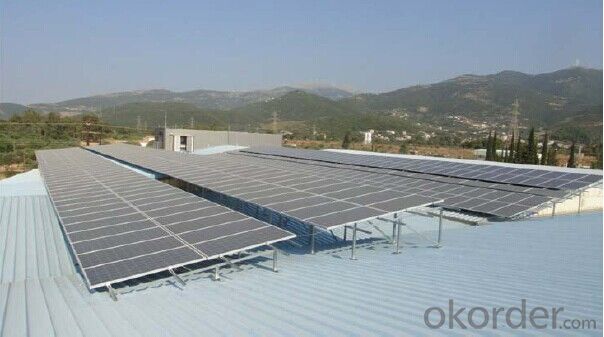

3600MTL | 4200MTL | 5000MTL-S | Growatt 5000MTL | |
| Input data | ||||
| Max. DC power | 4100W | 4800W | 5300W | 5800W |
| Max. DC voltage | 600V | 600V | 600V | 600V |
| Start Voltage | 120V | 120V | 120V | 120V |
| PV voltage range | 90V-600V | 90V-600V | 90V-600V | 90V-600V |
| MPPT work voltage range/ nominal voltage | 95V-600V/360V | 95V-600V/360V | 95V-600V/360V | 95V-600V/360V |
| Full load dc voltage range | 190V-580V | 175V-580V | 175V-580V | 175V-580V |
| Number of MPP trackers /strings per MPP tracker | 2/2 | 2/2 | 2/2 | 2/2 |
| Max. input current of tracker A / trackerB | 10A/10A | 15A/15A | 15A/15A | 15A/15A |
Max. input current per string of tracker A / trackerB | 10A/10A | 15A/15A | 15A/15A | 15A/15A |
| Output (AC) | ||||
| Rated AC output power | 3600W | 4200W | 4600W | 5000W |
| Max.AC power | 3600W | 4200W | 4600W | 5000W |
| Max. output current | 18A | 21A | 23A | 25A |
| AC nominal voltage; range | 220V/230V/240V; 180Vac-280Vac | 220V/230V/240V; 180Vac-280Vac | 220V/230V/240V; 180Vac-280Vac | 220V/230V/240V; 180Vac-280Vac |
| AC grid frequency; range | 50/60Hz;±5Hz | 50/60Hz;±5Hz | 50/60Hz;±5Hz | 50/60Hz;±5Hz |
| Power factor at rated power | 1 | 1 | 1 | 1 |
| THDI | <3% | <3% | <3% | <3% |
| AC connection | Single phase | Single phase | Single phase | Single phase |
| Efficiency | ||||
Max. efficiency | 97.6% | 97.9% | 97.9% | 97.9% |
FAQ
1. Have any design tool and how to use it?
Shine Design is the system design software just for inverters, It can conduct installers to figure out panel numbers for a system, panel numbers for each string, and which inverter model is suitable for the system. Moreover, it can print a design report after input all necessary parameters, can calculate DC/AC wire wastage, annual generation, etc.
2. Does the inverter have monitoring solutions for residential system?
For small rating system, we have wired two monitoring solution (ShineNet via RS232 or RS485). (a) Local wireless monitoring solution (ShineVision via RF module communication) (b) Global wireless monitoring solution (WIFI module via WIFI network)
3. Do you have free solution for monitoring?
ShineNet is an inverter monitoring software run in Windows XP, Windows Vista, Windows 7 operating system. It can monitor inverter via RS232 (or RS232 convert to USB cable) and RS485 wire connection. Customers can purchase the cable locally to get the inverter monitored, it is simple.
- Q: Photovoltaic grid-connected inverter without DC emc how will happen
- When solar or other light illuminates the PN junction of the semiconductor, a voltage (called a photogenerated voltage) occurs on both sides of the PN junction. This phenomenon is the famous photovoltaic effect.
- Q: Can a solar inverter be used with a solar-powered healthcare system?
- Yes, a solar inverter can be used with a solar-powered healthcare system. A solar inverter is an essential component of a solar power system as it converts the direct current (DC) produced by solar panels into alternating current (AC) that can be used to power various healthcare devices and equipment. This allows for the efficient and reliable operation of a solar-powered healthcare system, ensuring uninterrupted access to essential medical services even in remote or off-grid locations.
- Q: Can a solar inverter be used in a solar-powered desalination system?
- Yes, a solar inverter can be used in a solar-powered desalination system. A solar inverter is responsible for converting the direct current (DC) electricity produced by solar panels into alternating current (AC) electricity, which is required to power the desalination system. By utilizing a solar inverter, the solar energy generated can be efficiently utilized to operate the desalination process, making it a sustainable and environmentally friendly solution for producing fresh water from seawater.
- Q: How does a solar inverter handle voltage fluctuations from the solar panels?
- A solar inverter handles voltage fluctuations from the solar panels by employing a technique called Maximum Power Point Tracking (MPPT). The MPPT algorithm continuously monitors the voltage and current output of the solar panels and adjusts the operating point to ensure maximum power transfer. This allows the inverter to adapt to varying sunlight intensity and temperature conditions, efficiently converting the DC power generated by the panels into standard AC power. The inverter also incorporates voltage regulation and protection mechanisms to ensure stable and safe operation despite any voltage fluctuations.
- Q: Can a solar inverter be used with a solar water heating system?
- No, a solar inverter cannot be used with a solar water heating system. Solar inverters are designed to convert the direct current (DC) power generated by solar panels into alternating current (AC) power for use in electrical appliances. On the other hand, solar water heating systems use solar collectors to heat water directly, without the need for electrical conversion. Therefore, the two systems serve different purposes and are not compatible with each other.
- Q: Are solar inverters compatible with battery storage systems?
- Solar inverters and battery storage systems are indeed compatible. They play a vital role in combining solar power and battery storage. Solar inverters convert the DC electricity generated by solar panels into AC electricity, which can be used to power our homes and businesses. On the other hand, battery storage systems store excess solar energy for later use, enabling us to utilize solar power even when the sun is not shining. When paired with solar inverters, battery storage systems can be charged during the day using excess energy from the solar panels and then discharge that stored energy at night or during periods of high energy demand. To ensure compatibility, solar inverters used in battery storage systems come equipped with additional features and functionalities. For instance, they may have built-in charge controllers that regulate the charging and discharging of the batteries, ensuring optimal performance and longevity. Advanced inverters may also incorporate smart grid capabilities, allowing them to communicate with the utility grid and optimize energy flows based on grid conditions and electricity prices. All in all, solar inverters are vital components in seamlessly integrating battery storage systems with solar power. They enable us to maximize the advantages of clean and sustainable energy.
- Q: How does a solar inverter handle reactive power?
- A solar inverter handles reactive power by using power factor correction techniques. It actively manages the flow of reactive power between the solar panels and the grid, ensuring that the power factor remains close to unity. This helps to optimize the efficiency and performance of the solar system, while also maintaining the stability of the grid.
- Q: Can a solar inverter be used in conjunction with a power optimizer?
- Yes, a solar inverter can be used in conjunction with a power optimizer. In fact, this combination is commonly used in solar power systems to optimize energy production. The power optimizer helps maximize the performance of each individual solar panel by adjusting the voltage and current levels, while the solar inverter converts the DC electricity produced by the panels into usable AC electricity for the grid. Together, they enhance the overall efficiency and output of the solar system.
- Q: What is the role of a solar inverter in preventing underperformance?
- The role of a solar inverter in preventing underperformance is to convert the direct current (DC) electricity produced by the solar panels into alternating current (AC) electricity that can be used to power household appliances and be fed into the grid. The inverter also monitors the performance of the solar system, ensuring that it operates at maximum efficiency and identifying any issues or underperformance. By constantly optimizing the energy production and detecting any problems, the solar inverter plays a crucial role in preventing underperformance and maximizing the overall output of the solar power system.
- Q: How do you calculate the total power capacity for a solar inverter?
- To calculate the total power capacity for a solar inverter, you need to consider the maximum power output of the solar panels connected to it. The total power capacity of the inverter should be equal to or greater than the total maximum power output of all the solar panels combined. This ensures that the inverter can handle the maximum power generated by the solar panels and efficiently convert it into usable electricity.
Send your message to us
Solar Inverter 3600W-5000W Grid Tied Solar Inverter
- Loading Port:
- Shekou
- Payment Terms:
- TT or LC
- Min Order Qty:
- 10 pc
- Supply Capability:
- 10000 pc/month
OKorder Service Pledge
OKorder Financial Service
Similar products
Hot products
Hot Searches
Related keywords





